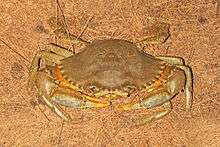Scylla serrata
| Scylla serrata | |
|---|---|
 | |
| Scientific classification | |
| Kingdom: | Animalia |
| Phylum: | Arthropoda |
| Subphylum: | Crustacea |
| Class: | Malacostraca |
| Order: | Decapoda |
| Infraorder: | Brachyura |
| Family: | Portunidae |
| Genus: | Scylla |
| Species: | S. serrata |
| Binomial name | |
| Scylla serrata (Forsskål, 1775) | |
Scylla serrata (often called mud crab or mangrove crab, although both terms are highly ambiguous, as well as black crab) is an economically important species of crab found in the estuaries and mangroves of Africa, Australia and Asia. In their most common form, the shell colour varies from a deep, mottled green to very dark brown.
Distribution
The natural range of Scylla serrata is in the Indo-Pacific. It is found from South Africa, around the coast of the Indian Ocean to the Malay Archipelago, as well as from southern Japan to south-eastern Australia, and as far east as Fiji and Samoa.[1] The species has also been introduced to Hawaii and Florida.[1][2]
Ecology
A study on tidal flats in Deception Bay in Queensland found juvenile crabs (20–99 mm or 0.8–3.9 in carapace width) were resident in the mangrove zone, remaining there during low tide, while subadults (100–149 mm or 3.9–5.9 in) migrated into the intertidal zone to feed at high tide and retreated to subtidal waters at low tide.[3] Adults (150 mm or 5.9 in and larger) were caught mainly below the low tide mark, with small numbers captured in the intertidal zone at high tide.[3]
These crabs are highly cannibalistic in nature; when crabs undergo moulting, other hard-shelled ones sometimes attack the moulting crabs and devour them. The females can give birth to a million offspring which can grow up to 3.5 kg (7.7 lb) in size and have a shell width of up to 24 cm (9.4 in) wide.
Aquaculture and consumption

Interest in the aquaculture of this species has been high due to the high demand/price for them, high flesh content, and rapid growth rates in captivity. In addition, they have a high tolerance to both nitrate[4] and ammonia (twice that of the similar sized Portunus pelagicus), which is beneficial because ammonia-N is often the most limiting factor on closed aquaculture systems.[5] Their high ammonia-N tolerance may be attributed to various unique physiological responses which may have arisen due to their habitat preferences.[5] However, their aquaculture has been limited due to the often low and unpredictable larval survival. This may be due to inadequate nutrition, disease, "moult death syndrome" (due to their highly cannibalistic behaviour during the megalopa stage), inadequate protocols (e.g. suboptimal environmental conditions), or a combination of all.
S. serrata can be kept easily in home aquaria when smaller, but will outgrow small setups. They are very active and will eat almost any conventional sinking pellets; they also consume some small fish pieces and vegetable matter. They are tolerant of most water conditions and are generally a very hardy and entertaining species.
Generally cooked with their shells on, when they moult their shells, they can be served as one of many types of soft shell crab. Some consider them to be among the tastiest of crab species, and demand for them is large in South and Southeast Asian countries, where they are often bought alive in the markets. In the northern states of Australia and especially Queensland, mud crabs are relatively common and generally prized above other seafood by the general public.
Mud crabs can be killed by placing them in a freezer for up to two hours before cooking.[6]
References
- 1 2 "Species Fact Sheets: Scylla serrata". Food and Agriculture Organization. Retrieved September 2012. Check date values in:
|access-date=(help) - ↑ J. Masterson (1 December 2007). "Scylla serrata". Indian River Lagoon Species Inventory. Smithsonian Marine Station at Fort Pierce. Retrieved 11 September 2012.
- 1 2 B. J. Hill, M. J. Williams and P. Dutton (1982). "Distribution of juvenile, subadult and adult Scylla serrata (Crustacea: Portunidae) on tidal flats in Australia". Marine Biology. 69 (1): 117–120. doi:10.1007/BF00396967.
- ↑ N. Romano & C. Zeng (2007). "Effects of potassium on nitrate mediated alterations to osmoregulation in marine crabs". Aquatic Toxicology. 85 (3): 202–208. doi:10.1016/j.aquatox.2007.09.004. PMID 17942166.
- 1 2 N. Romano & C. Zeng (2007). "Acute toxicity of ammonia and its effects on the haemolymph osmolality, ammonia-N, pH and ionic composition of early juvenile mud crabs, Scylla serrata (Forskål)". Comparative Biochemistry and Physiology A. 148 (2): 278–285. doi:10.1016/j.cbpa.2007.04.018. PMID 17540593.
- ↑ Dominic Mapstone. "Live Mud Crab – Scylla serrata". Retrieved 5 December 2009.
External links
| Wikimedia Commons has media related to Scylla serrata. |
- Australia: Queensland government page on mangrove crab aquaculture
- Cycle of the mud crab
- Life Cycle of the Mud Crab – Fishnote No.11 March 2007, Northern Territory